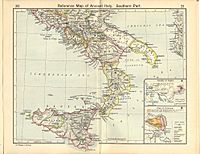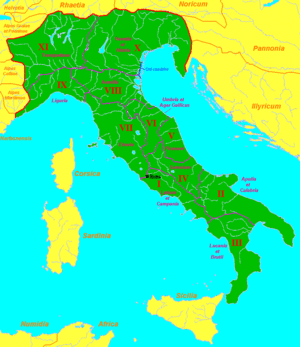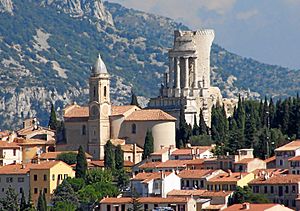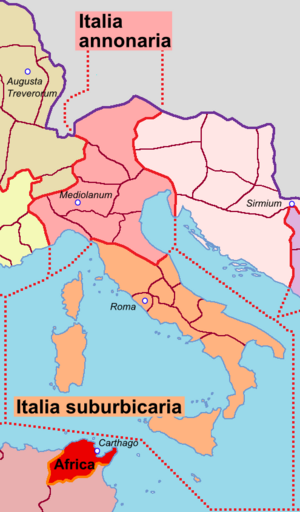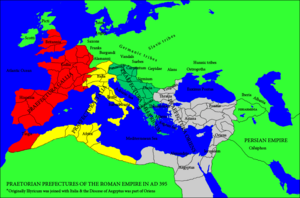Roman Italy facts for kids
Quick facts for kids
Italy
Italia (Latin)
|
|||||||||
|---|---|---|---|---|---|---|---|---|---|
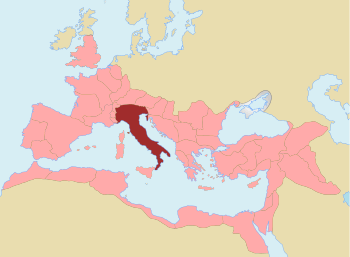
Roman Empire at its greatest extent c. 117 AD, with Italy in red and Provinces in pink.
|
|||||||||
| Capital | Rome: full-fledged until Diocletianic times, from then on mostly only de jure. Mediolanum and Ravenna: Imperial residences; de facto capital in the Late Empire (of the whole Empire or only the Western part) | ||||||||
| Common languages | Latin | ||||||||
| Religion | Roman polytheism, followed by Nicene- Chalcedonian Christianity | ||||||||
| Government | Mixed constitution | ||||||||
| Legislature | Senate and People of Rome | ||||||||
| Historical era | Classical Antiquity, Late Antiquity | ||||||||
| Population | |||||||||
|
• AD 1
|
estimates vary from 4 to 10 million (c.1 million in Rome) | ||||||||
| ISO 3166 code | IT | ||||||||
|
|||||||||
Italia (also known as Roman Italy) was the original home of the ancient Romans. In Roman mythology, the god Jupiter promised Italy to Aeneas of Troy and his family. His descendants, Romulus and Remus, are said to have founded Rome.
Beyond myths, Rome began as a city-state in Italy. It changed from a kingdom to a republic. Then it grew into a huge empire. The Italian peninsula was home to many different groups. These included the Gauls in the north, Etruscans and Latins in the center, and Greeks in the south.
Italy became one united area as Rome expanded. Rome formed strong partnerships with most local tribes and cities. This Italian alliance was key to Rome's rise. It helped Rome win major wars, like the Punic and Macedonian wars. These wars happened between 200 and 300 BC.
As Rome created Roman provinces across the Mediterranean, Italy kept a special role. It was seen as the "ruler of the provinces." During the peaceful time of the Pax Romana, it was called the "governor of the world" and "parent of all lands." This meant that in Italy, Roman officials had police power. Italians also had special rights and benefits.
The time between the late 2nd century BC and the 1st century BC was difficult. It started with slave uprisings called the Servile Wars. Then, rich leaders (Optimates) fought against reformers who wanted to help common people (Populares). This led to the Social War in central Italy.
After the Social War, all Italians were granted Roman citizenship. This right was later given to people in Cisalpine Gaul when Julius Caesar became Roman Dictator. When Rome changed from a Republic to an Empire under Octavian Augustus, Italy supported him. He then divided Italy into eleven regions, from the Alps to the Ionian Sea.
This led to over two centuries of peace and stability. Several emperors achieved great things during this time. Claudius added Britain to the Empire. Vespasian put down a major revolt and fixed the money system. Trajan conquered new lands. Marcus Aurelius was known as a wise "philosopher king."
The Crisis of the Third Century hit Italy hard. But the Roman Empire survived. In 286 AD, Emperor Diocletian moved the western capital from Rome to Mediolanum (modern Milan). Later, in 292 AD, islands like Corsica, Sardinia, Sicily, and Malta were added to Italy. Milan and Ravenna became the main capitals for the Western Empire.
The Bishop of Rome (the Pope) slowly became more important. Emperor Constantine helped Christianity grow. In 476 AD, Italy fell under the control of Odoacer when the last Western Roman Emperor, Romulus Augustulus, was removed from power. Italy was not fully united again until the 19th century. This happened under the House of Savoy, forming the Kingdom of Italy. This kingdom became the modern Italian Republic in 1946.
Contents
What Made Roman Italy Special?
After the Social War ended in 87 BC, Rome gave full rights to its Italian allies. All Italic peoples received Roman citizenship. For centuries, Italy was the heart of the Roman Empire. However, starting in the 3rd century AD, the government and cultural focus began to shift eastward.
In 212 AD, the Edict of Caracalla gave Roman citizenship to all free men in the Empire. Christianity also became the main religion from Constantine's time (306–337 AD). This made cities in the East more powerful.
Constantinople (modern Istanbul) became very important. It was given the status of an eastern capital in 359 AD. As a result, Italy's importance slowly decreased compared to the provinces. This led to the Empire being split into two parts in 395 AD. These were the Western Roman Empire (with its capital at Mediolanum, now Milan) and the Eastern Roman Empire (with its capital at Constantinople).
In 402 AD, the Western Imperial residence moved from Milan to Ravenna. This showed that the city of Rome was losing its power. Rome was even attacked and looted in 410 AD for the first time in nearly 800 years.
The History of Italy's Borders
The area called Italia changed its borders over time. Early Greeks used the name for the land between the strait of Messina and a line connecting the gulf of Salerno and gulf of Taranto. This is roughly the modern region of Calabria. Later, the Romans extended the name to include the Italian Peninsula up to the Rubicon river. This river was between Northern and Central Italy.
In 49 BC, Julius Caesar gave Roman citizenship to the people of Cisalpine Gaul. In 42 BC, this area became part of Italy. This extended Italy's northern border to the southern base of the Alps. Under Emperor Augustus, people in the Aosta Valley and western Alps were conquered. This moved Italy's western border to the Varus river. The eastern border was moved to the Arsia river in Istria.
Later, in the late 3rd century AD, Italy also included the islands of Sicily, Corsica and Sardinia, plus Raetia and part of Pannonia. The city of Emona (modern Ljubljana, Slovenia) was the easternmost town in Italy.
How Augustus Organized Italy
At the start of the Roman Empire, Italy was a mix of territories. Some cities, called municipia, had some independence from Rome. Others, called coloniae, were founded by the Romans. Around 7 BC, Augustus divided Italy into eleven regiones (regions). Pliny the Elder wrote about these regions in his book Naturalis Historia:
- Regio I Latium et Campania
- Regio II Apulia et Calabria
- Regio III Lucania et Bruttium
- Regio IV Samnium
- Regio V Picenum
- Regio VI Umbria et Ager Gallicus
- Regio VII Etruria
- Regio VIII Aemilia
- Regio IX Liguria
- Regio X Venetia et Histria
- Regio XI Transpadana
Augustus and his family gave special attention to Italy. They built many public structures, including a large network of Roman roads. Italy's economy thrived. Farming, crafts, and industries grew, allowing goods to be sent to other provinces. Italy's population also grew. Augustus ordered three censuses to count Roman citizens. The numbers were 4,063,000 in 28 BC, 4,233,000 in 8 BC, and 4,937,000 in 14 AD.
Changes by Diocletian and Constantine
During the Crisis of the Third Century, the Roman Empire faced many problems. These included invasions, military chaos, civil wars, and very high inflation. In 284 AD, Emperor Diocletian brought back stability. He made big changes to the government to keep order. He created the Tetrarchy, where the empire was ruled by two senior emperors (Augusti) and two junior emperors (Caesars).
Diocletian also made provinces smaller by doubling their number. This reduced the power of governors. He grouped provinces into dioceses, each led by a vicarius (deputy). Rome's importance declined because it was far from the troubled borders. Diocletian and his co-rulers lived in different imperial cities. Diocletian lived in Nicomedia (near the Persian border), and Maximian lived in Milan (closer to European borders).
Under Diocletian, Italy became the Dioecesis Italiciana. It included Raetia. It was divided into these provinces:
- Liguria (modern Liguria and western Piedmont)
- Transpadana (eastern Piedmont and Lombardy)
- Rhaetia (eastern Switzerland, western and central Austria, parts of southern Germany and northeastern Italy)
- Venetia et Histria (modern Veneto, Friuli-Venezia Giulia, Trentino-Alto Adige and Istria)
- Aemilia (Emilia-Romagna)
- Tuscia (Etruria) et Umbria (Tuscany and Umbria)
- Flaminia (Picenum and former Ager Gallicus, in modern Marche)
- Latium et Campania (coastal parts of Lazio and Campania)
- Samnium (Abruzzo, Molise and Irpinia)
- Apulia et Calabria (modern Apulia)
- Lucania et Bruttium (Basilicata and Calabria)
- Sicilia (Sicily and Malta)
- Corsica et Sardinia
Constantine later divided the Empire into four praetorian prefectures. The Diocesis Italiciana became the Praetorian prefecture of Italy (praefectura praetoria Italiae). It was then split into two dioceses, still including Raetia. The two dioceses and their provinces were:
Diocesis Italia annonaria (Italy of the annona - its people had to provide supplies for the court, administration, and troops, first in Milan and then in Ravenna)
- Alpes Cottiae (modern Liguria and western Piedmont)
- Liguria (western Lombardy and eastern Piedmont)
- Venetia et Histria (Istria, Friuli-Venezia Giulia, Trentino-Alto Adige, Veneto and eastern and central Lombardy)
- Raetia I (eastern Switzerland and western Austria)
- Rhaetia II (central Austria, part of southern Germany, and part of northeastern Italy)
- Aemilia (the Emilia part of Emilia-Romagna)
- Flaminia et Picenum Annonarium (Romagna and northern Marche)
Diocesis Italia suburbicaria (Italy "under the government of Rome")
- Tuscia (Etruria) et Umbria (Tuscany, Umbria and northern coastal Lazio)
- Picenum suburbicarium (Piceno, in southern Marche)
- Valeria Sabina (modern province of Rieti, other parts of Lazio, Umbria, and Abruzzo)
- Campania (central and southern coastal Lazio and coastal Campania except modern province of Salerno)
- Samnium (Abruzzo, Molise and mountain areas of modern Campania)
- Apulia et Calabria (modern Apulia)
- Lucania et Bruttium (modern Calabria, Basilicata and the province of Salerno in modern Campania)
- Sicilia (Sicily and Malta)
- Sardinia
- Corsica
Italy in Late Antiquity
In 330 AD, Constantine finished rebuilding Byzantium, renaming it Constantinople. He set up the imperial court, a Senate, and government offices there. This new city became the eastern capital in 359 AD. After Emperor Theodosius died in 395 AD, the Empire was divided. Italy became the home base of the Western Roman Empire.
Because of Alaric's invasion in 402 AD, the western capital moved from Mediolanum to Ravenna. Alaric, king of the Visigoths, attacked and looted Rome itself in 410 AD. This was the first time in 800 years that Rome had been sacked. Northern Italy was attacked by Attila's Huns in 452 AD. Rome was looted again in 455 AD by the Vandals.
By the 5th century, the Western Roman Empire had weak control over Italy. Its coasts were often attacked. In 476 AD, Romulus Augustulus gave up his title as emperor. This formally ended the Western Roman Empire. Italy then came under the rule of Odoacer and his Kingdom of Italy. Later, it was ruled by the Ostrogothic Kingdom. These new Germanic rulers continued to use the Roman government system. They also recognized the Eastern emperor in Constantinople as their nominal ruler.
In 535 AD, the Roman Emperor Justinian invaded Italy. This led to a devastating twenty-year war. In 554 AD, Justinian issued a law that kept most of Diocletian's organization. The "Prefecture of Italy" was restored under Roman control during Justinian's Gothic War.
However, the Byzantines lost most of Italy due to the Lombard invasion in 568 AD. They only kept areas like the Exarchate of Ravenna (a corridor from Venice to Lazio) and some parts of southern Italy.
Images for kids
See also
 In Spanish: Italia (época romana) para niños
In Spanish: Italia (época romana) para niños



